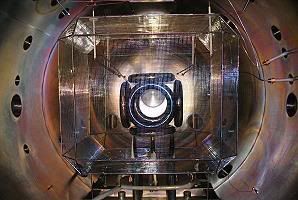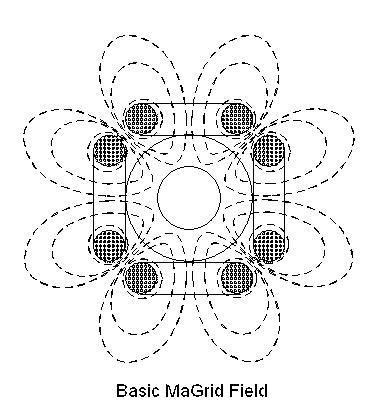Tom Ligon, a researcher who worked witth Dr. Bussard on the Polywell machines has added a few points to Polywell - As I Currently Understand It. Let me note to start that he thinks the basic description is excellent (with minor corrections). You can read what Tom has to say at General Fusion Theory. I'm going to put it here in my own words to make sure my understanding is correct. If I make a mistake I'm sure Tom will correct it when he gets back from vacation in a couple of weeks or so. Keep your eye on this space.
First point of minor correction. The magnets can be all North poles facing in or all South poles facing in. I picked one just to make the explanation simpler.
The next part is trickier. Here is where the electromagnets come in. We replace the ordinary magnets with coils of wire. You put a current through them and you have an electromagnet. The coils will be shaped to match the face of the solid it conforms to. If the solid is a cube the coils will be square. If the solid is an octahedron the coils would be triangular.
Now here is a part that wasn't clear to me earlier. Once you have the coils all wrapped up nice and tidy like you cover them with a metal sheath which then becomes the + grid.
Here is a nice picture of what it looks like in the WB-6 experimental version:

Note that the coils do not conform to the shape of the solid picked. That is definitely an experimental error and will be corrected in the next version. This is what the Bussard folks call the MaGrid which stands of course for Magnetic Grid. Cooling is definitely going to be a problem because the cooling properties of a high vacuum are not very good. It is why we use vacuum bottles to keep things hot.
Tom points out that the Deuterium should be injected inside the grid so that the atoms are quickly ionized. That gives you a number of engineering problems I'm not going to go into here. Let us get the theory down first. You can't engineer what you don't understand.
Tom says that the plasma physics is probably the hardest thing to understand in the machine. I'd agree with that. You have electric fields, magnetic fields, coils, and charged particles. This is probably one of the toughest areas of physics because of the interactions. Every thing affects everything all at once.
Let's start this next stage with the magnetic field. Here is a nice drawing of what it would look like before any particles are circulating:

Used by permission of Tom Ligon, copyright 2007
Next lets look at it with electrons in the mix:

Used by permission of Tom Ligon, copyright 2007
So the electrons are injected into the center of the machine and last a long time. Any electrons that leak out are attracted back in by the grid. As long as the magnetic fields keep the electrons from hitting the grid they can just keep cycling along inside the machine. Long electron life time is one of the keys to net energy production.
Tom claims that in operation the circulating currents inside the machine are very high. Maybe millions of amps. This current of course, like any current, generates a magnetic field. This new magnetic field pushes back on the field around the coils making the field stronger near the coils. Now I'm having trouble visualizing a spherical current that creates north poles on all sides of a shere. Of course if the circulating currents were mirrors of the currents in the coils that could happen. However, I don't see how that happens naturally without creating forces that drive the electrons out of the center of the machine. We will put this down to details to be explained later.
OK some how you have electrons madly circulating around the center of the machine. When I get a better explanation of how this happens I will give it to you. These electrons form a potential well between the electrons in the center and the grid. The potential difference is about 80% of the grid to shell voltage. This is good because it means the electrons are less likely to have enough energy to reach the grounded outer shell where they are lost.
Now you start injecting fuel into the machine.The fuel either comes in as ions from an ion gun or it comes in without a charge and some of it is ionized by collisions with the madly spinning electrons. The fuel is affected by the same forces as the electrons but a little differently because it is going much slower. About 64 times slower in the cae of Deuterium fuel (a hydrogen with one neutron). Now these positively charged Deuterium ions are attracted to the virtual elctrode (the electron cloud) in the center of the machine. So they come rushing in. If they come rushing in fast enough and hit each other just about dead on they join together and make a He3 nucleus (two protons and a neutron) and give off a high energy neutron.
Ions that miss will go rushing through the center and then head for one of the grids. When the voltage field they traveled through equals the energy they had at the center of the machine the ions have given up their energy to the grids (which repel the ions), they then go heading back to the center of the machine where they have another chance at hitting another ion at high enough speed and close enough to cause a fusion.
Hopefully this happens often enough so that there is more energy coming out than going in by a lot.
As you can see there are a lot of loose ends to be tied down on this. There is lots more to understand what is actually happening. Fortunately there are a lot of amateurs working on this and progress is being made with electrostatic machines.
More details on these experiments are going to have to come out before any serious engineering could start.
There is more than enough information here for a serious experimenter to build a test machine to see if this path to fusion holds promise. You might not even need to try fusing Deuterium to do diagnostics on virtual cathode formation and other details on what is going on in the plasma.
Since diagnostics, and not power, are the object, the electron guns could be made oversize to compensate for electron losses. If you could cool the grid with something like Flourinert or liquid nitrogen and crank up the electron injection really high despite the losses a lot of useful information could be found.
So I see two steps at the very beginning:
1. Verify virtual cathode production in a magneto/electric field of minimum size.
2. Scale it up to a test reactor capable of operating the grid at around 30KV (max) at useful currents with Dueterium fuel. It should be possible to test how reaction rates scale with voltage on the grid and current through the coils. You can also monitor electron gun currents vs reaction rates (neutron production) to get some idea of the losses.
The next step after you have some good data (you might need 4 or 5 proto types) is to scale it up to a machine with 1 KW energy production, follow that with 100 KW, then 10 MW. Start the scale up when you are at least 70% confident of the next design. For experimental purposes lots of things can be fixed along the way. In fact depend on the fact that problems that are insignificant at 1 KW will be serious obstacles at 10 MW. That is the key to development. Fixing problems as they come up so as to meet targets for cost, development time, specifications, etc. Solvitur Ambulando.
WB-6 coils were .15 meter across and looked like this under construction:

They were run at around .1 Tesla for .25 milliseconds.
The final article in this series is:
Polywell - Making The Well

















